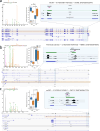Deep learning to decode sites of RNA translation in normal and cancerous tissues
- PMID: 39894899
- PMCID: PMC11788427
- DOI: 10.1038/s41467-025-56543-0
Deep learning to decode sites of RNA translation in normal and cancerous tissues
Abstract
The biological process of RNA translation is fundamental to cellular life and has wide-ranging implications for human disease. Accurate delineation of RNA translation variation represents a significant challenge due to the complexity of the process and technical limitations. Here, we introduce RiboTIE, a transformer model-based approach designed to enhance the analysis of ribosome profiling data. Unlike existing methods, RiboTIE leverages raw ribosome profiling counts directly to robustly detect translated open reading frames (ORFs) with high precision and sensitivity, evaluated on a diverse set of datasets. We demonstrate that RiboTIE successfully recapitulates known findings and provides novel insights into the regulation of RNA translation in both normal brain and medulloblastoma cancer samples. Our results suggest that RiboTIE is a versatile tool that can significantly improve the accuracy and depth of Ribo-Seq data analysis, thereby advancing our understanding of protein synthesis and its implications in disease.
© 2025. The Author(s).
Conflict of interest statement
Competing interests: G.M. is an employee of OHMX Bio. Z.M. and R.G. are employees of Novo Nordisk Ltd. J.R.P. reports receiving honoraria from Novartis Biosciences. J.R.P. is a paid consultant for ProFound Therapeutics. A.I.N. receives royalties from the University of Michigan for the sale of MSFragger and IonQuant software licenses to commercial entities. The remaining authors declare no competing interests.
Figures



Update of
-
Deep learning to decode sites of RNA translation in normal and cancerous tissues.bioRxiv [Preprint]. 2024 Mar 25:2024.03.21.586110. doi: 10.1101/2024.03.21.586110. bioRxiv. 2024. Update in: Nat Commun. 2025 Feb 02;16(1):1275. doi: 10.1038/s41467-025-56543-0. PMID: 38585907 Free PMC article. Updated. Preprint.
References
-
- Brito Querido J., Díaz-López I. & Ramakrishnan V. The molecular basis of translation initiation and its regulation in eukaryotes. Nat. Rev. Mol. Cell Biol. 1–19. 10.1038/s41580-023-00624-9 (2023). - PubMed
-
- Calviello, L., Hirsekorn, A. & Ohler, U. Quantification of translation uncovers the functions of the alternative transcriptome. Nat. Struct. Mol. Biol.27, 717–725 (2020). - PubMed
MeSH terms
Substances
Grants and funding
- CI-127-24/Damon Runyon Cancer Research Foundation (Cancer Research Fund of the Damon Runyon-Walter Winchell Foundation)
- 21-23983/Alex's Lemonade Stand Foundation for Childhood Cancer (Alex's Lemonade Stand Foundation)
- K08-CA263552-01A1/U.S. Department of Health & Human Services | NIH | National Cancer Institute (NCI)
- K08 CA263552/CA/NCI NIH HHS/United States
- R01 GM094231/GM/NIGMS NIH HHS/United States
LinkOut - more resources
Full Text Sources

